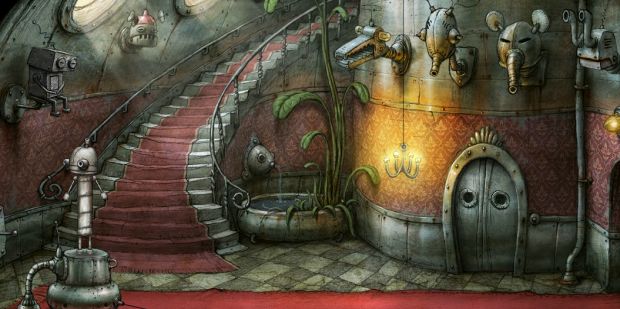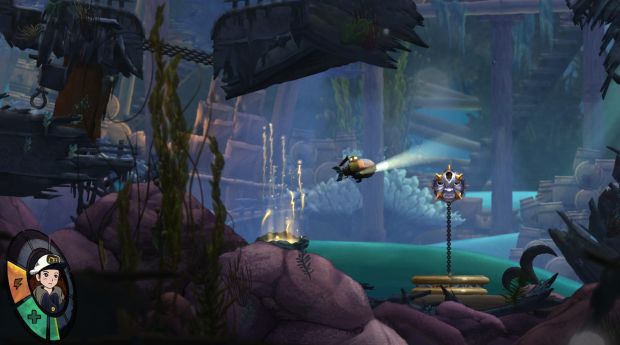Every game is ambitious. It s not easy to turn a beautiful idea into a finished, playable game as developers have said time and again, sometimes it feels almost impossible. As miraculous as finishing any game might be, not all games are created equal. Some stretch the boundaries of technology to their breaking point. Others take a leap into the unknown with new design schools, often so effectively that years later, it s hard to remember them ever having to be invented.
Think, for example, of Monkey Island s Three Trials structure, as used by almost every adventure afterwards. Or its sequel s Four Map Pieces , as later picked up by BioWare. And sometimes, both art and science combine to push the envelope and we get something truly, impossibly special. Here are our picks for the top 20 ignoring the very early games that had to prove computers could handle gaming at all.
For more on some of the most monumental games ever to grace the PC, check out our feature on the most important PC games.
King's Quest (1983)
For the longest time, adventure games were where people looked to see the latest innovations. King s Quest set that bar early on, jumping from simple text and pictures to 3D environments, huge worlds, and a fairytale land of mystery to both wander and wonder at. Admittedly, the last part was helped by some dreadful puzzles. King s Quest was originally commissioned by IBM as the showpiece for its long-forgotten PCJr system, but the series would go on to demonstrate just about every major technological advancement for the mainstream: ADLIB sound, VGA graphics, full speech, and high resolution. 3D didn t work out so well, but until that point, King s Quest was where many players went to get their glimpse of the ever-advancing future.
Commander Keen (1990)
If you want to experience pure hell, try the average 80s PC platform game. Long before making Doom, the team that would be id Software wanted to prove that the PC could handle experiences that played as smoothly as dedicated consoles. Commander Keen wasn t just a fluid experience by the standards of the time, but a fast one, with pogo-jumping, shooting and big levels to explore. Looking back, it s hard to appreciate what a development it was, but we re talking an era where games like the original Duke Nukem (or Nukum either way, the one who wore a pink suit and watched Oprah) were constantly being held up as the PC s answer to Mario. Commander Keen didn t qualify either, but it paved the way for many sequels and the formation of id itself.
A bit of bonus ambition: before making Keen, id tried to convince Nintendo to let it port Super Mario Bros. 3 to the PC by building a working demo (in their off hours in a single week, no less). Nintendo said no thanks, but you can see footage of the demo here.
Maniac Mansion (1987)
If you made a game like Maniac Mansion right now, people would still rightly call it ambitious. A choice of seven characters, each with their own skills. A non-linear adventure with five different endings depending on choices and characters. Real time elements, like ringing the doorbell and having a character come downstairs to check on it. Puzzles involving multiple characters in different rooms of the house or simply the option to do things like put a kid in an empty swimming pool and then fill it back up. And on top of all of this, Maniac Mansion brought the world the SCUMM system (Script Creation Utility For Maniac Mansion) that would define about half the adventure game market for the next decade. All of this, in 1987. Few adventures have ever done so much.
Ultima Underworld (1993)
Like most of the games on this list, Ultima Underworld is a fusion between ambitious technology and ambitious design the design side specifically being to take one single dungeon and try to breathe life into it. To add nuance to its different races, there to be talked to instead of just beaten up. The Stygian Abyss wasn t just a battlefield. It was a fallen community. A place to live in. The experience of being thrown into a dungeon and just expected to survive.
What really sold it though, if your PC could run it, was the technology. Before even Wolfenstein 3D, Ultima Underworld offered a full 3D environment complete with slopes, lighting effects and more, in a bit of technology that could only have been more impressive if well, the viewing window had been a bit bigger. Underworld 2 greatly increased the scope of the game, visiting other worlds and making it a bit easier to see, but what the first one managed remains a technological victory worthy of any heroic age.
Ultima VII: The Black Gate (1993)
Get used to seeing the word Ultima. Ultima VII came out in 1993, and still games like Divinity: Original Sin measure themselves against its success. Its biggest success was creating a living world, where peasants went home at night, weather blasted the world, your companions had to be fed, and, yes, where you could get some flour and water, mix it into dough, stick it in an oven, and get your own deliciously crispy bread. On top of this was an incredibly mature story that continued the series love of more advanced storytelling than most games of the era (previous ones having tackled racism, the perversion of good, and the quest for a hero worth being called one) with a complex tale of good intentions subverted by an otherworldly being of pure, but incredibly smug malevolence.
Ultima Online (1997)
Last time! Where Ultima VII brought a living world to single-player RPGs, Ultima Online brought it to multiplayer. It wasn t the first MUD or MMO, but most of them followed the Diku model popularised by Everquest: go forth, slay. Ultima Online wanted to create an actual world, where players would gather resources, craft houses, become shopkeepers and more, with hero just one of the many careers available. It wasn t without its problems, the first of them being the discovery that given a world to explore and exploit, players will typically turn it into a survival of the fittest Hell. But, its scope, its potential, and the joy of it when it worked created an epic experience that s still running today, and stories like the assassination of Lord British that will never cease to amuse.
The Elder Scrolls II: Daggerfall (1996)
The second of the Elder Scrolls games asked one hell of a question: could you make a world with over 750,000 characters and a map the size of Britain actually feel like a world? We re putting this one here instead of Elite, partly to ring the changes, but mostly because few procedural games have pulled it off so well enough political relationships, guilds, interesting stuff to discover, and cool mechanics like being able to get turned into a werewolf or vampire.
It s not that difficult to create raw space. Daggerfall s own predecessor Arena offered even more. Its sequel, Morrowind, did what most games tend to, and hand-crafted a far smaller area in intricate detail. But for a moment with Daggerfall, we had a game that showed you could be epic, procedural and interesting, without simplifying everything down to the ASCII style of Rogue or putting all the impetus on the player to pretend that there was more going on behind the surface than was ever going to meet the eye.
Duke Nukem 3D (1996)
While another case of a game that s not aged all that well, Duke Nukem 3D was the game that took FPS action out of military bases and sewers and relocated it to city streets, cinemas, and other more realistic locations. That plus a complicated scripting system to blow them all up, clever tricks to fake a 3D engine (even though it was only 2.5, much like Doom) and endless imagination took Duke from being a moderate shareware star to the highest tiers of game characters. No wonder the world was willing to wait so long for Duke Nukem Forever. Even if it wasn t worth it, in the end.
Outcast (1999)
The PC has never really had its own Legend of Zelda. Action. Exploration. A whole new world to explore. Outcast is arguably the closest its come.
A graphical powerhouse of a game that immediately impressed with its freedom, with the AI of its characters, with the glorious effects in everything from jumping into water, to your personal scanner rippling gridmarks across the scenery. There was only one problem. It was all done with voxels at a time when 3D cards were finally allowing for decent polygonal worlds, putting all the work on CPUs that couldn t handle it. If you could play it, Outcast was an unforgettable experience. Too bad for most people it was one that had to wait until the GOG version that finally made it run, long after its prime.
Grand Theft Auto 3 (2001)
It s easy to dismiss the sheer effort that goes into creating a city. After all, we ve walked, run, driven and carjacked around so many. GTA 3 wasn t even the first, with racing games in particular having set the pace. But could you get out of the racing cars and ramble? Enjoy a pumping gangster soundtrack? Run around with automatic weapons and go on missions with a huge cast of crazy characters? Just sit back and listen to an hour of talk radio? Nope. GTA III was magic, and so many sequels on, it s still raising the bar for what virtual cities can and should be.
Give or take a few terrible cock jokes, anyway.
EVE Online (2003)
Ultima Online intended to let players call the shots. It didn t quite work. With EVE Online however, CCP had the courage to actually let it happen, creating one of the most talked about online games of the last few years. Tales of empires at war, of con artistry on a scale that would make Count Lustig blink, the epic sagas of backstabbings and betrayals that no other game can match. CCP likes to describe EVE using the phrase EVE is Real , and while there may not be any starships flying distant galaxies under your favourite forum s command, they still have a point.
Civilization (1991)
All of human history in a single game? There s not much more to be said, really. As achievements go, the only bigger one would be making it one of the greatest games of all time. Not to cast aspersions on the likes of Elite for creating a universe in slightly fewer bytes than the average person would make in a toothpaste and peperami footlong, but the thing about space is that it is mostly empty. Just saying. The world however, in as many ways as you can imagine? That s ambition, even if using it educationally does mostly teach people never, ever to mess with Gandhi.
Deus Ex (2000)
Real world. Real conspiracies. Where do we even begin? Deus Ex not only set out to create some of the most realistic real-world locations we d ever seen (not a tautology the games before hadn t exactly done a great job most of the time), but also turn them into nothing short of a psychopath s toolbox. Multiple paths and solutions. Characters who reacted to your decisions. Tiny decisions determining who lives and who dies. All wrapped in some of the best writing and wrapping the PC had known up to this point. There s a reason why so many years on, it s the original Deus Ex that still stands out as both one of the greatest games ever, and the template of a dream for future immersive simulators to study at the feet of as they try to surpass it.
Dwarf Fortress (2006)
Simulations don t get any deeper than this. Literally, or figuratively. Dwarf Fortress or to give it its full title, SLAVES TO ARMOK: GOOD OF BLOOD, CHAPTER II: DWARF FORTRESS is an ASCII gem best summed up by its creator saying in 2011 that we shouldn t expect version 1.0 for at least twenty years. That s what you get in a game so crazily detailed that a cat can go into a tavern, pick up spilled alcohol on its paws, wash itself off, and get drunk. This was never intended behaviour, just the sum of smaller sub-routines coming together and making their own reality. In retrospect, that twenty years to complete doesn t sound so much at all.
Half-Life 2 (2004)
In a way, Half-Life 2 s most ambitious part isn t even in the game. Valve had an idea for a new store, called Steam . You might have heard of it. Half-Life 2 was, if not its Trojan horse, then its vanguard. You wanted to play the best FPS ever made at the time? Then you got it through Steam. And that worked out pretty well.
Even if you ignore Steam, Half-Life 2 reinvented the shooter with its focus on physics, with every chapter introducing new mechanics and new exciting concepts like the gravity gun or playing point-defense with turrets. It also created a continuous world like no other, putting the final nail into the coffin of games that didn t prize a sense of presence as well as place in their shooter campaigns. Much copied, but still rarely bettered, Half-Life 2 set out to be both the best shooter around, and its next great leap forwards.
Planetside (2003)
Some games just shouldn t be possible. Even knowing the technology that powers them, the epic battles of the Planetside series have always had a degree of magic to them. For the handful of players lucky enough to have a system and connection that could handle it, heading out into one of Planetside s huge battles is a defining moment in games. For the rest, it says a lot that it still felt just as impressive when Planetside 2 rolled along only a couple of years ago. 5v5? 12v12? That s all well and good. But an explosive, expanding, all-access battlefield where the war never stops? That s military action with a little sorcery mixed into the formula, even today.
Spore (2008)
It failed. Yes, we know. It failed. But this is ambitious games we re talking about, and few games shot higher than Spore. Leading a tiny organism through every stage of life. Constructing it using the surprisingly powerful and fun editor. Sending it out to meet other players aliens in a great throbbing galaxy full of freshly created life. That may have been the point where the charm ran out, but the open-ended action and procedural generation and early focus on user generated content that led up to that point still stands out as a technological, if not gaming success.
Crysis (2007)
"But can it run Crysis?" was a relevant joke among PC gamers for at least three years for good reason: well after 2007, Crytek's shooter could still bring CPUs and graphics cards to their knees. Crysis took Half-Life 2's early use of physics and applied it to a dense, free-roaming world. Being able to shoot a tree, watch it fall over, and then shoot the trunk into smaller pieces was revelatory players gladly gave up framerate in favor of insane graphics and physics processing. Cutting edge AI and the systems-driven sandbox gave Crysis the depth to match its insane graphics, and no shooter since has managed quite the same combination of wow and substance.
DayZ (2012)
From its beginnings as a popular mod, DayZ spawned one of the most popular genres in gaming today. The framework for this multiplayer zombie survival game was Arma 2, up until that point one of the most ambitious simulation games and a bastion for fidelity and scale on PC. DayZ built upon Arma 2 s ambition, borrowing and later adapting its 225 km2 terrain, Chernarus, which was created from satellite-modeled slices of the Czech Republic.
The month that DayZ caught on, creator Dean Hall was already laying out incredible plans about features he wanted to add, as he told us in an interview. Underground structures. Dog companions. Realistic disease systems. A couple months later we were hearing about destructible terrain and player cities. Part of Hall s stated approach was to experiment with big, bad ideas, but the reality of implementing them quickly in Arma s Real Virtuality engine for DayZ proved to be a massive challenge.
Outside of these early technical roadblocks, as a multiplayer game DayZ was uniquely trusting. The systems that DayZ inherited from Arma granted it some depth, and being dropped into a massive, hostile environment with no instruction empowered players to tell their own stories, often through surprising, weird interactions with other survivors.
Our 2012 mod of the year remains in Early Access after arriving on Steam as a standalone game on December 2013.
The Witcher 3: Wild Hunt (2015)
It s amazing to think that in just three games, CD Projekt Red has gone from unknown studio to absolute top-tier RPG developer. The Witcher 3 is their masterpiece, from the hand-crafted world to the sheer number of characters and plots. It s a game that excels on every level, from scripting subtle enough for a character to break off combat when they hear your name, to the global nature of some of the most amazing graphics and scenery in any PC game ever, and the sheer artistry of just about every major quest or aside. You never know what s coming next, from the teary humanity of the Bloody Baron s agonising storyline, to a gaggle of Witchers drinking too much, dressing up in drag, and drunk-dialling wizards across the whole continent.
Star Citizen (20XX?)
No, it s not out yet. It doesn t matter. Chris Roberts play to create the ultimate space game already qualifies. Elite style action combined with a dedicated, AAA Wing Commander-style campaign starring Mark Hamill. First person action aboard ships. Deep space exploration. A persistent universe allowing for company, or the solitude of the stars. A crowd-funded budget of $117,259,371 and counting, with players happily putting down real money for in-game ships and unlocking features like pets and modular ship designs and new AI characters to scatter around on planetside environments. If it s not the greatest game ever, expect literal, physical riots.















